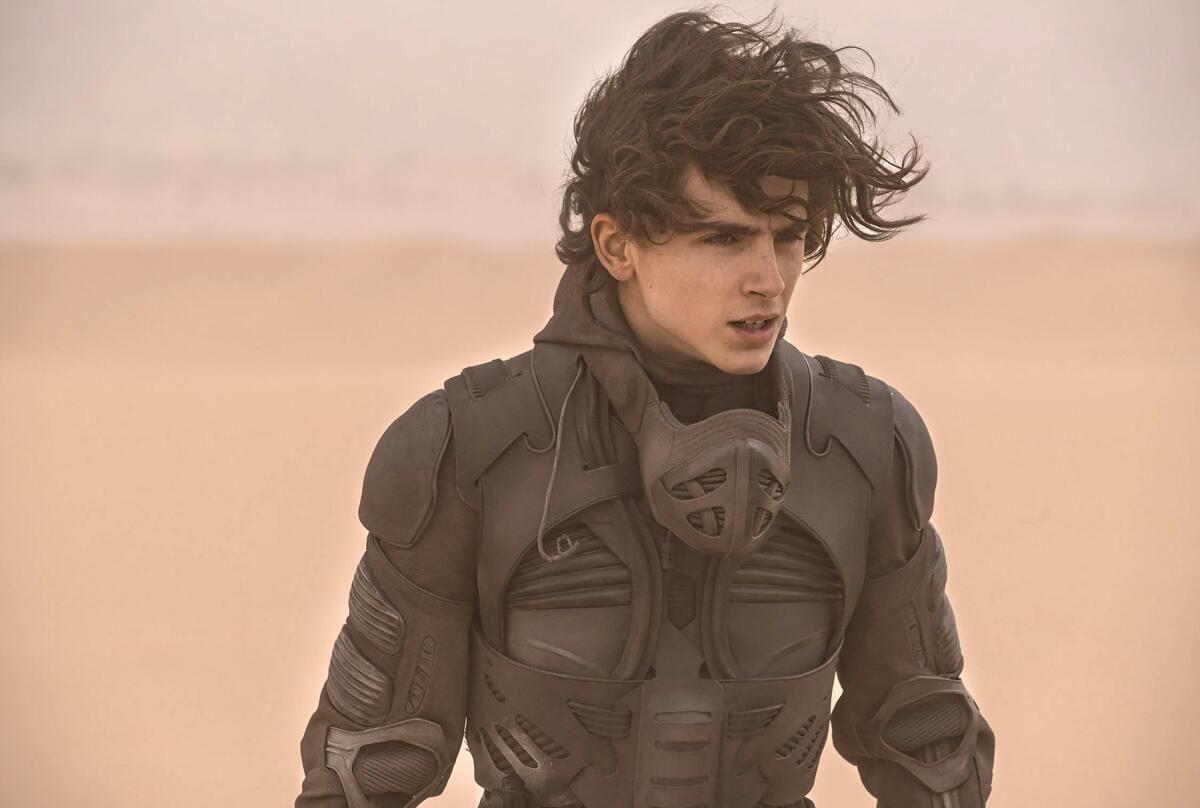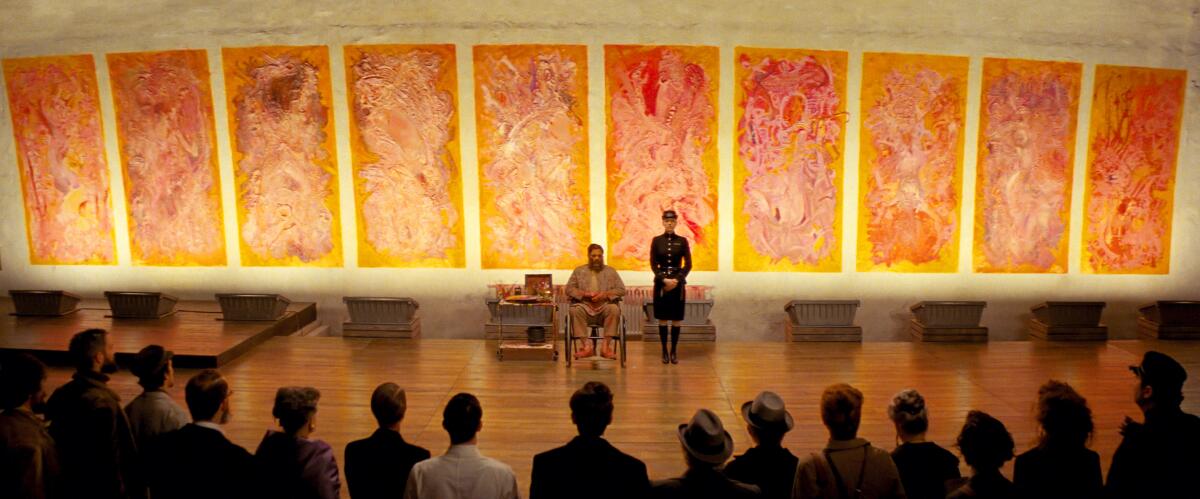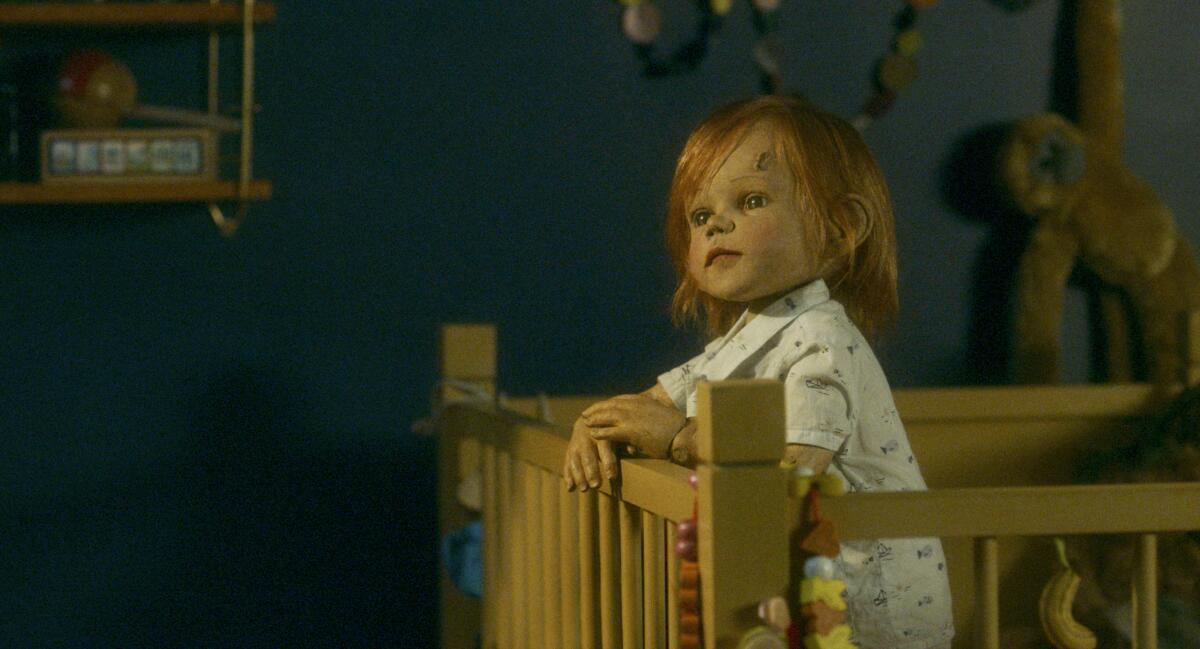These unique creations for three awards season films had us at hello

Every awards season, much oohing and aahing is done over meticulously rendered sets and gloriously tailored costumes in movies. But many contenders go one step beyond and present something unique and special — an object or gizmo that without it the whole film could flop over. We’re putting a microscope on three such critical objects — “Dune’s” stillsuits, “The French Dispatch’s” paintings, and “Annette’s” puppet — and exploring how they were born, what makes them tick and what makes them as critical as the stars on the marquee.
Stillsuit, “Dune”

What is it? On the parched desert planet Arrakis (a.k.a. “Dune”) created by novelist Frank Herbert, water is so precious it has attained religious significance. The Fremen, who live in the desert caves, have harnessed the need for hydration with a full-body “stillsuit” complete with tubes, pumps and pouches to recycle and repurpose every drop of water from the body, from sweat to urine.
Creation story: “Frank Herbert led the way, and Denis [Villeneuve, director] took up the mantle,” says three-time Oscar-nominated costume designer Jacqueline West, who created the suits with co-costume designer Bob Morgan. “It’s the centerpiece of the film.” Resembling something between flexible armor and death-match protective gear, the suits look the part in the film. (West suggests they could even work like they do in the book.) She assembled a team of 25 devoted to creating around 250 of the charcoal-gray suits, which were modeled from sketches and a sculptor’s prototype. Made of a combination of acrylic and porous cotton (plus a complex set of tubes woven into the fabric), they also had to wick moisture from the body for real, since the film was being shot in Jordan. “They had to keep the actors cool,” she says. “They were like second skins.”
Final result: “Each actor came up with a very different look,” says West. “I thought this gave them a ‘mod-ieval,’ instead of medieval, look without making them look like they were in a spacesuit. Denis didn’t want anything that looked like a video game — more like a world starting over.”
Moses Rosenthaler’s artworks, “The French Dispatch”

What are they? Within director Wes Anderson’s “Dispatch,” one segment features imprisoned killer Moses Rosenthaler (Benicio Del Toro/Tony Revolori), who becomes a cause célèbre with his paintings — abstract nudes of a volunteer prison guard, Simone. His pièces de résistance are 10 5-by-10-foot panels painted as a fresco on a prison wall — an impossible-to-remove item, or so it would seem.
Creation story: Rosenthaler artwork creator Sandro Kopp and Anderson met on 2012’s “Moonrise Kingdom,” for which Kopp created a book cover that appeared in the film. For “Dispatch,” Anderson told Kopp the paintings “needed to be quite abstract, and the sizes were set, and the primary colors were set,” says the artist. “Other than that, very little was decided beforehand.” Inspirations for Kopp, who had three months to create the art, included Willem de Kooning, Francis Bacon and Jenny Saville, and his medium was a mixture of acrylic, glue and plaster to mimic oil paints — and promote cracking to indicate age.
Final result: “Most of my designs went out the window,” he says. “[Anderson] said, ‘Show me how to paint flesh, that’s great, now use just geometric shapes, then attack it with a palette knife, then set it on fire.’” Meanwhile, Kopp also had to craft the more realistic paintings Rosenthaler created before he found his muse. But there’s one sketch in the film Kopp doesn’t think is his: the “perfect sparrow.” “I must have done 40 or 50 versions, and [Anderson] ended up not using them,” he says. “I wouldn’t be surprised if he did it himself.”
Annette puppet, “Annette”

What is it? When your titular character spends most of the movie as a puppet made of resin, paper, wood, foam and hardware, you’re setting yourself a serious challenge, as director Leos Carax did. Though the offbeat musical’s character was originally written for a live baby/toddler, the demands of the role were too great for a flesh-and-blood child, so Carax hired La Pendue Company’s Estelle Charlier (aesthetic designer) and Romuald Collinet (technical designer) to create a manipulatable doll.
Creation story: Carax wanted the puppet to look like a young girl he’d met two decades earlier, so he gave Charlier and Collinet photos and a short film. “He wanted Annette to be endearing, feminine and a special character, a baby soprano … and especially not to fall into the [uncanny valley, in which an artificial human can feel creepy],” they write in a shared email. “We made nine busts with different manipulation whose limbs and masks are interchangeable…. And in total there are 15 faces.” During shooting, very little special effects were used; when they weren’t able to manipulate the puppet on set or with a green background, actors sometimes had to take over.
Final result: Featuring the girl from birth to age 6, there’s no question that she’s an artifice, yet it works within the elevated, artistic construct of the film. “We tried to merge the poetry of our work, or company, with the one of the universe of Leos, inspired by the music, the actors, the light, the decors … and to combine the world of puppetry with the cinema,” they write.
More to Read
From the Oscars to the Emmys.
Get the Envelope newsletter for exclusive awards season coverage, behind-the-scenes stories from the Envelope podcast and columnist Glenn Whipp’s must-read analysis.
You may occasionally receive promotional content from the Los Angeles Times.







